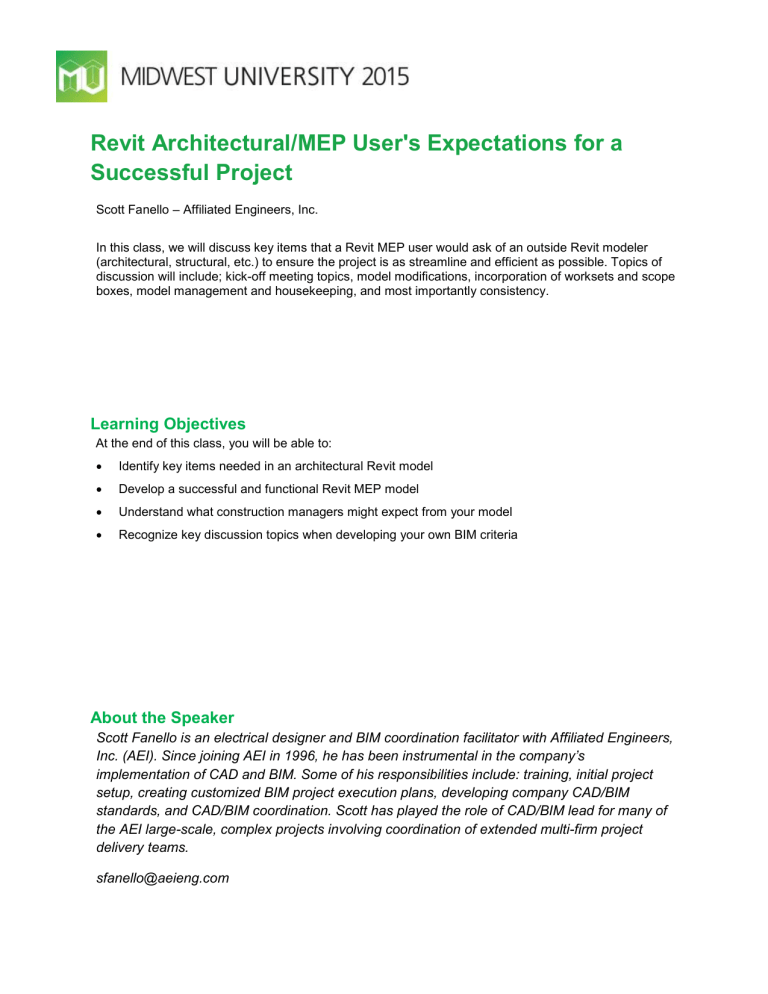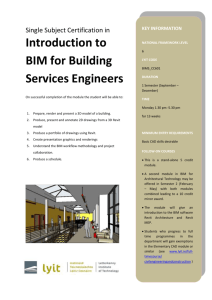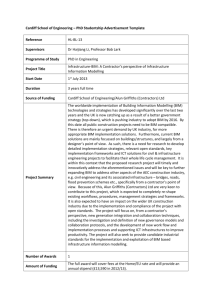Revit Architectural/MEP User's Expectations for a successful project

Revit Architectural/MEP User's Expectations for a
Successful Project
Scott Fanello – Affiliated Engineers, Inc.
In this class, we will discuss key items that a Revit MEP user would ask of an outside Revit modeler
(architectural, structural, etc.) to ensure the project is as streamline and efficient as possible. Topics of discussion will include; kick-off meeting topics, model modifications, incorporation of worksets and scope boxes, model management and housekeeping, and most importantly consistency.
Learning Objectives
At the end of this class, you will be able to:
Identify key items needed in an architectural Revit model
Develop a successful and functional Revit MEP model
Understand what construction managers might expect from your model
Recognize key discussion topics when developing your own BIM criteria
About the Speaker
Scott Fanello is an electrical designer and BIM coordination facilitator with Affiliated Engineers,
Inc. (AEI). Since joining AEI in 1996, he has been instrumental in the company’s implementation of CAD and BIM. Some of his responsibilities include: training, initial project setup, creating customized BIM project execution plans, developing company CAD/BIM standards, and CAD/BIM coordination. Scott has played the role of CAD/BIM lead for many of the AEI large-scale, complex projects involving coordination of extended multi-firm project delivery teams. sfanello@aeieng.com
Revit Architectural/MEP User’s Expectations for a Successful Project
BIM Kick-off Meeting
Why have BIM kickoff meetings? To make sure that ALL of the participants on the project team are in agreement and on the “same page”. There are various items that members of the team can change; however, what may seem like a small change to one may have a major impact on another’s work. The BIM kickoff meeting is intended to be a BIM planning session. This meeting should include as many key team members as possible. Below is a list of topics to be discussed during the kickoff meeting.
Goals and Objectives
• Client Goals
– Coordination
– Facility Management
– Does the client understand BIM?
• Projects Goals
– Coordination
– Value added
– Efficiency
Key Contacts
• Project Leads
– Firm
– Project Role
• BIM Managers
– Firm
• Technical Expert(s)
Technologies
• Software & Versions
– Modeling - Revit, Rhino, Bentley, AutoCAD 3D, etc. Understand you can’t go backwards in Revit
– Coordination – Navisworks, 360 Glue, etc.
– File Transfer - FTP, Newforma, Buzzsaw, etc. or Revit Server or other BIM cloud server?
• Hardware – Discuss any special computer hardware issues or concerns
Workflow
• Number of Models - Not only per firm, but if more than one per discipline, determine best way to break the project into multiple models.
• Linking Strategies - It is important to consider the size of the project, as well as the structure of the team, when considering the linking strategy. Changing the linking strategy midway through a project will be a significant amount of work and likely cause confusion.
2
Revit Architectural/MEP User’s Expectations for a Successful Project
• Coordinates - Shared coordinates, origin to origin, etc.
• Phasing - Will phasing be used? If so, get agreement on how the team thinks the phasing will be set up. Phase mapping will need to happen between the linked files and the host file for it to work correctly.
• Design Options - Understand that there is no access to design options through the linked file, so everyone will need to make sure that they save and transmit files with the proper design option states enabled.
Deliverables
• Schedule
• Model Transfers
– How often
• Weekly vs. Daily - The frequency of updates can have a major impact on the amount of work required to reconcile problems with a new background. Those that received updates frequently may not have issues or problems with the updated backgrounds. On the other hand, if there were massive changes to the architectural background (since the previous update), identifying all of the work that had to be re-done in the
MEP model was almost impossible. The users will need to weigh the costs of frequent background updates against the cost of potential rework to make a good decision about how often to update.
– Syncing capabilities
– Frozen backgrounds – How soon prior to certain deliverables or milestones will backgrounds be “frozen”?
• Plotting format - PDF, DWF, Other
Scope
• Level of Detail/Development - is a reference that enables practitioners in the AEC
Industry to specify and articulate with a high level of clarity the content and reliability of
Building Information Models at various stages in the design and construction process.
The LOD Specification utilizes the basic LOD definitions developed by the AIA for the
AIA G202-2013 Building Information Modeling Protocol Form and is organized by CSI
Uniformat 2010. It defines and illustrates characteristics of model elements of different building systems at different Levels of Development. This clear articulation allows model authors to define what their models can be relied on for, and allows downstream users to clearly understand the usability and the limitations of models they are receiving. [1]
[1] Level of Development (LOD) Specification 2013 www.bimforum.org/lod
3
Revit Architectural/MEP User’s Expectations for a Successful Project
Standards
• Client - Are there client standards that need to be met? Campus, CAD, BIM, etc.
• BIM Manual - Created from the topics being discussed during BIM meeting(s).
• Naming - Naming conventions (models, sheets, views). Not to be changed midproject! If there is a standard name for the "Levels" it is much easier to decide which ones need to be copied.
• Grids/Levels - Whose grids and levels are to be used, the architect or the structural engineer? This is important, as MEP users must know which levels and grids should be copied. The MEP team doesn't want to become the team that is trying to copy both the structural grids and the architectural grids and keep them coordinated.
• Fonts – Client, architect or other standard. Is there a minimum text size that can be used? Is everyone going to use all caps? To some this is important, to others, not so much, but it is easier to make sure everyone agrees than it is to go back and change it later.
• Families – Title blocks, key plans, view titles, symbols (FA), etc
• Parameters - Shared parameters are parameters that you can add to families or projects and then share with other families and projects. They give you the ability to add specific data that is not already predefined in the family file or the project template. Shared parameters are particularly useful when you want to create a schedule that displays various family categories.
• Housekeeping – File size is one of the more often over looked areas of file management… poor management in this area can lead to a very frustrated team. With proper file management we have taken open and sync times from 15 min down to 1 min.
When you have a project team of 12 highly active users in the model that adds up to a lot of time saved each day. Purging model, compacting model, deleting nonessential sections & 3D views.
Coordination
• Spatial Coordination - Prior to putting any work into the models a planning session should be held to define what systems go where in the ceiling spaces. This zoning diagram should be the basis for defining your elevations when laying out your systems in
Revit.
• BIM Meetings – Who should all participate? How often should they occur? Who will lead them?
• Clash Detection – When will clash detection sessions start? How often will they be held?
Who will lead them?
Revit expectations for architect
Following is a list of items that we have found, based on past experience, helped us be the most efficient and productive when working with external architectural Revit models.
4
Revit Architectural/MEP User’s Expectations for a Successful Project
• Single point contact for BIM issues
• Provide all teams the border family
– Include keyplan family in lieu of keyplan drafting views. Also include check boxes for the different areas to turn on or off the shading as needed. This will save the team time and make it easy to update if needed down the road.
– Share unique families (plan title/designator, scale & north arrow with on/off parameter, etc)
– Use shared parameters and project info
– Communicate updates to the border and/or project information to EVERYONE!
• Use origin to origin positioning as first option as this is the least complicated method of linking models. If using shared coordinates determine Project/Survey points PRIOR to sending out for the first time. If possible locate the Project Point at a set point of your building ie: column line A&1 or slab corner, etc. Try to avoid moving the coordinates after initial project setup as the more we move them around the more likely we are to have miss aligned models.
• Set true north - It affects MEP calculations
• Set up MEP floor plan views for MEP to by linked view in their model. This allows for consistent backgrounds among all trades.
• Label the view for Navisworks exactly “Navisworks”. Navisworks unfortunately does not recognize it if it’s in all caps. This is only relevant if you are using native Revit files in
Navisworks instead of exporting views out of Revit to NWC ’s.
• Add a yes/no parameter for full height walls, so they can be easily filtered and checked against in Navisworks.
• Do not move the building – It is strongly suggested not to move the building (in elevation or shared coordinates)!
• Utilize Worksets
– Matchlines
– Levels & Grids
– Room separation lines
– Equipment - Any elements placed on generic equipment should be placed on an appropriate workset (i.e. M-Generic Equipment or P-Generic Equipment). There are many times when we try to turn off an element but it’s on generic equipment so we lose other elements that are relevant to our work. This will allow for better organization of equipment and allow each trade to turn off the equipment they do not want to see.
– Furniture - turning off furniture can clear up complex system designs.
– Scope boxes - If a single floor of the project fills more than one sheet, please use scope boxes to break up your building into sections. We can copy them into our model and match your areas much easier.
• Properly enclosed rooms so our spaces will match your rooms. When rooms are not enclosed properly this affects our spaces and our calculations. When possible don’t use more than one linked models to enclose rooms. If this is needed please created room
5
Revit Architectural/MEP User’s Expectations for a Successful Project separation lines in lieu of setting all the models to room bounding. If more than one linked model is used we will have to re-path all the links in the model each time we get an update. If we don’t re-path, our room tags lose their info and turn to question marks.
• Consistent fire partitions (built-in walls or lines)
• Windows vs. openings - Do not use openings where you intend to have windows. Without the glazing our energy calculations will be incorrect.
• Ceiling height tags - Provide ceiling height tags on ceiling plans so as to avoid cutting a section for every room in the project.
• Modify elements vs. deleting - To the largest extent possible, try to modify host elements
(walls, floors, roofs, ceilings, etc.) rather than delete them and put in a new one, as when they delete elemen ts everyone’s systems become "orphaned" and then just float in space.
• Careful what you purge - Of course purging the model before posting is always appreciated, but do not detach from central and discard worksets prior to sending. Some believed this would help, but this gets rid of a level of control that is useful.
• Parameter for packages - Create a shared parameters file and add a parameter for each package that goes out. This will allow us to generate sheet indexes directly from our
Revit models.
• Communicate areas of the model that are in flux. We do not want spend time modeling in those areas just to find out we will need to remodel based on changes that are forth coming.
Pulling It All Together
Create your own BIM Plan!
The Project BIM Deployment/Execution/Implementation Plan is intended to help document how
BIM will be utilized on a project; it's a planning tool. It will be a key instrument for planning project specific processes and requirements of BIM on your project. Having your BIM process planned out and documented will help ensure that BIM is being utilized appropriately for your project and will give your team clear direction.
– Vital document to ensure a well-executed BIM project.
– Gives accountability.
– A BIM plan should cover all aspects of a project, not just standards. This should cover your project from start to finish.
– It should be a living document that the team meets at the end of each project phase to update.
– Hold the team to the documented agreements.
6








